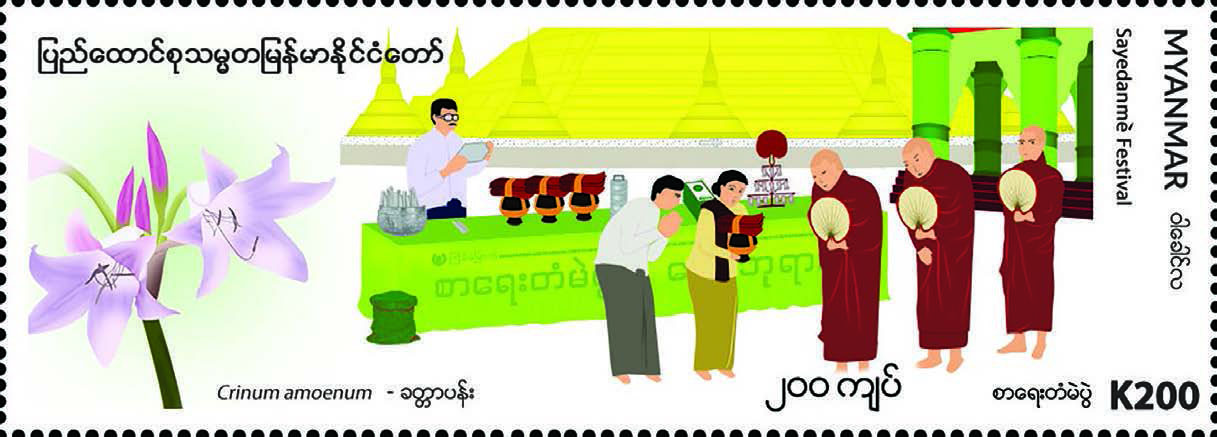WAKHAUNG, the 5th month of the Myanmar Lunar Calendar approximately corresponds to August. The literal meaning of Wakhaung is the middle of Wa [Rain Retreat of three months of Monsoon]. In stone inscriptions of old days this month is mentioned as Nan Kala [နံကာလ] meaning ploughing season or the month for agricultural activities. A Myanmar folk rhyme ဝါဆို၊ ဝါခေါင် ရေဖောင်ဖောင် [ In Waso and Wakhaung, there are billows of rain water]. Being the peak of rainy season, the entire country is inundated with rain water.
Astrologically named Simha [ဟသိင်္ဟ] Leo its symbol is Lion. A species of ground lily called khattar [crinum amoenum] blooms profusely to be designated as the flower of this month. The origin and history of the lot casting festival of Wakhaung may be traced to the lifetime of Lord Gotama Buddha. While residing at the Weiluwun Vihara at the capital of Yazagyoe, a famine hit the city. There was a shortage of food. Not enough rice food could be provided for all monks. When this matter was reported to Lord Buddha himself expounded seven different ways of providing food for the monks. They are as follows—
(1). Sangha bhat - food offered to all monks
(2). Uddesa bhat - food offered to one or two monks.
(3). Vimantana bhat - food offered to the invited monks.
(4). Salaka bhat – food offered to monks chosen by casting lots.
(5). Pakkhika bhat – food offered to monks on the waxing and waning moon days.
(6). Uposathika bhat – food offered to monks on Sabbath days.
(7). Patipadika bhat – food offered to monks on the day after the Sabath day.
Lord Buddha approved all above seven types of food offering to the monks. Since that time Salka bhat – food offered to monks chosen by casting lots became a common practice. As directed by Lord Buddha, one monk was chosen by monks from among them to be appointed as ''Bhattuddesaka" to take the charge of offering food to monks chosen by lot casting. This monk must have the following special qualifications.
(1). Good health
(2). Activeness
(3). Managerial skill
(4). Freedom from bias and prejudice
(5). The ability to keep the correct list of allotted and unallotted monks.
The first monk chosen for that charge in the lifetime of Lord Buddha was the son of the Malla King Ashin Maha Thera Datba. He discharged the duty of allotting Uddesa-bhat, Nimanta bhat and Salaka bhat with fairness and correctness.
It was Myanmar kings who prescribed the lot casting festival in Wakhaung because three months of Rain Retreat used to have a food shortage for monks. Later not only food but also other offertories for monks is offered by lot casting including monastery. In Myanmar language lot-casting is called sarye-tan pwe [စာရေးတံပွဲ].
is not offering stationeries-slates, slate pencils, books, pens, ball pens and ink, etc. as some Myanmar people of today especially young generations mistakenly think. In some rural monasteries you can still find lot-casting festivals and pieces of bamboo sticks in a bamboo tube for lot casting.
In the stone inscriptions of Ancient Bagan offering food to monks by casting lots was mentioned. In lines 22 and 23 of Saw Hla Win Pagoda Stone Inscription of AD 1268, 1290, 1291. In the Pinya Period of Myanmar history [1298- 1312 AD] King Thihathu [1298- 1312 AD] donated 5 storey gilt wooden monastery to Hsu-twinpyit Sayadaw monk by lot-casting. Myanmar literature is rich in the forms of diverse Verses and poems describing Sayetan pwe [lot casting festivals] of Wakhaung month loota, eh-chin, Lay-cho, Tay htat verses of authers U Yar, Pho Thudaw U Min, Lu U Min, Min Khwey, U Ponnya etc, described about Lot-casting festivals in their literary pieces. In Myanmar music and songs of classical lot-casting festivals were sung and re-enacted.
At such monthly festivals, festive atmosphere is created by Myanmar people of all age groups. Elderly Myanmars are in religious mood-keeping Sabbath, reciting Paritta, groups. Elderly Myanmar are in religious mood-keeping Sabbath, reciting Paritta, meditating, donating middle and young age groups turn to festive activities-singing, dancing, re-enacting. Amature performing artists of the localities joyfully participate in such festivals. Village girls and ladies lead the procession. They are in their fineries, different chair knot styles, sanakha face make-up bright beautiful dresses holding artistically arranged flowers and other offertories accompanied by their parents. The procession followed by bands of local male youths overjoyed, play percussion and wind instruments—flute, oboe,drums cymbals and bamboo clappers, singing folk, or pop songs and dancing youthful demces such as Ozi, Dho bat, Naban Zan dances or ultra-modern pop and hip-hops. They make everyone happy or even merry like them. Some watchers of middle or old age group join them. These village amateur performers receive money award from the watchers, even from some monks.
The writer of this article in his younger days at school, college and even state scholar in London, never failed to participate in such festivals. He received money award for his Ozi, Dho bat and Naban san dances. Myanmar monthly festivals are traditional, religious, socio-cultural and international regardless of race, religion, creed and social status any one friend or stranger can join in eating, drinking and all merry-makings.




